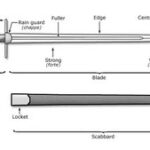Ten years ago, my father-in-law gave me a Japanese World War II sword. He had received it from a good friend who had fought at Okinawa during the war. He had brought it home as a war souvenir. For years, it sat in many a closets.
After I got it home, I also put t in my closet. However, my curiosity got the better of me and I started to do research on it and swords in general. Then came the movie Kill Bill 1. The movie explained how swords were made and the value placed on them.
At the beginning of World War II, there were families in Japan that had made swords as a trade. Similar to blacksmith. This trade might have been in their family for generations. Special swords were made for military leaders throughout Japan. Once the war began, they started making them in a factory. The difference in the value of a sword is determined by many things. Those made by an individual sword-smith or family have higher value than those made in a factory.
All parts of a sword have different values. But, the one main part is the blade. After all, it is the main part of the sword. I also discovered, that they had to be maintained and cleaned a special way.
The blade can easily be removed from the handle. There are one or two small pins that slide from the handle into the blade. These pins are made of many things. Mine are made from brass. When I took the handle off my sword, I noticed a lot of Japanese writing or symbols on this part of the blade. There were six on one side and one on the other side of this part of the blade.
I used trace paper to get a better view of these emblems. Now I don’t understand Japanese writings at all but, I could clearly trace and distinguish them. I sent pictures of the markings to a person who specialized in reading these. He told me that the date September 1939 and name Take Hisa appeared on the blade. He also mentioned that there was one other name on it. He didn’t know if it was a factory or family name. He did not know if Take Hisa was the maker or owner of the sword. It may have been the name of the soldier that carried it into battle. I am still researching it.
During my research, I have learned other things. All swords of this type or confiscated at Japanese borders and they are destroyed. They have been since the end of the war. There is also great value placed on these swords by many individuals. I have seen some swords sold for over $4,000.
Since the movie Kill Bill, many swords were made and sold as replicas from the movie. Their worth isn’t that good. I don’t think my sword is worth much either.
Most older swords can be traced back to five schools of sword making. Each school was located in one of the five provinces. Each school had their own trademark and was considered as a tradition.
My sword is a Type 94 Non Commissioned Officers Sword. It was made to resemble a Commissioned Officers sword.
In 1958, there were more Japanese swords in America than there were in Japan. Most or all were brought home as war souvenirs. That is what my sword was.
I also know that my sword is made out of Japanese Steel called Tamahagane (jewel steel). That is where the value is in my sword. One part of my sword is no longer present. The Tusuba (hilt) has long been gone. These parts were made with special designs for identity. some were very valuable and some were not.
Finally, I don’t plan to keep this sword much longer. Having two growing grandsons, means the possibility of a safety risk. Even though I have it put away, children find a way to get at things. Similar to a gun, it is a weapon.


